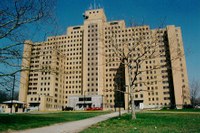2 July 2007 update: Simone D. has had more then 200 forced electroshocks. The State of New York went to court to give even more. Simone D.’s attorney, Dennis Feld, fought valiantly. But the courts agreed to order even more forced electroshock. Electroshock is also known as electroconvulsive therapy or ECT.
by Dennis B. Feld – dbfeld@courts.state.ny.us
July 2, 2007
Simone D. appeal
The New York Court of Appeals turned back the challenge brought by Mental Hygiene Legal Service to the order authorizing 30 shocks [also known as “electroconvulsive treatments or ECT] over Simone D.’s objection, which order was issued in late November, 2005 and had been stayed by the appellate process.
This result will likely, and shortly, have Simone D. strapped to a gurney and wheeled into Creedmoor’s ECT suite for “maintenance” shock treatments in additional to the at least 148 shocks she has received since 1999 (and over 200 during her lifetime).
Although the Appellant’s Brief and the Amici Brief made these numbers clear to the Court as well as the very questionable efficacy of maintenance shock at that extraordinary high end, the Court’s ruling never made such a recitation in ultimately affirming the authorized regimen.
Also lost on the Court, at least in our feeling that the Court’s very technical decision was in part driven by an unwillingness to be critical of the effort taken by psychiatrists to care for an involuntary confined and “problematic” population, was the fact that remission of Simone’s condition had never been achieved by ECT nor did ECT offer any hope that Simone D. would get to the point of being found capable of making her own treatment decisions or ever being released from the hospital.
So, there is nothing we can affirmatively take from our over one-and-one-half year [18 month] battle in this matter and utilize in confronting New York State’s continuing turn to involuntary maintenance shock to control the behavior of individuals of whom the new (as well as the old) psychotropic drugs fail to render compliant and manageable to the State’s satisfaction.
And, unfortunately we are left with intermediate appellate precedent that finds a patient’s greater interaction with her peers and diminished skirmishes with staff to be benefits which are “crystal clear” and evidence that ECT has improved the quality of her life.
This case also underscores the Office of Mental Hygiene’s failure to explore non-medical alternatives such as transferring Simone D. to a unit/facility that has Spanish-speaking clinicians who can approach and try to treat her in her primary language and also provide her cultural accommodations.
Instead, the only alternative to shock the State will readily offer is a panoply of medications that even its experts acknowledge do not work.
Out of this continuing blunder, Kim [Darrow, attorney and colleague] penned two lines in the Appellant’s Brief submitted to New York’s High Court that should earn a place in Leonard [Roy Frank’s electroshock] Quotationary:
“After appellant had been subjected to more than a decade of linguistic isolation at Creedmoor, the hospital gave up on transferring her to a ward with a Spanish-speaking psychiatrist after less than six weeks. Yet Creedmoor had not abandoned more intrusive treatment with multiple drugs, even after several years of admitted failure.”
Maybe that’s the irony that convinces us that we need to continue to fight these battles if only to attempt to instill some sense into institutional psychiatry and continue to see if we can get the courts to understand that sometimes setting limits on what clinicians do in the name of treatment is indeed the best jurisprudence.
Document Actions


